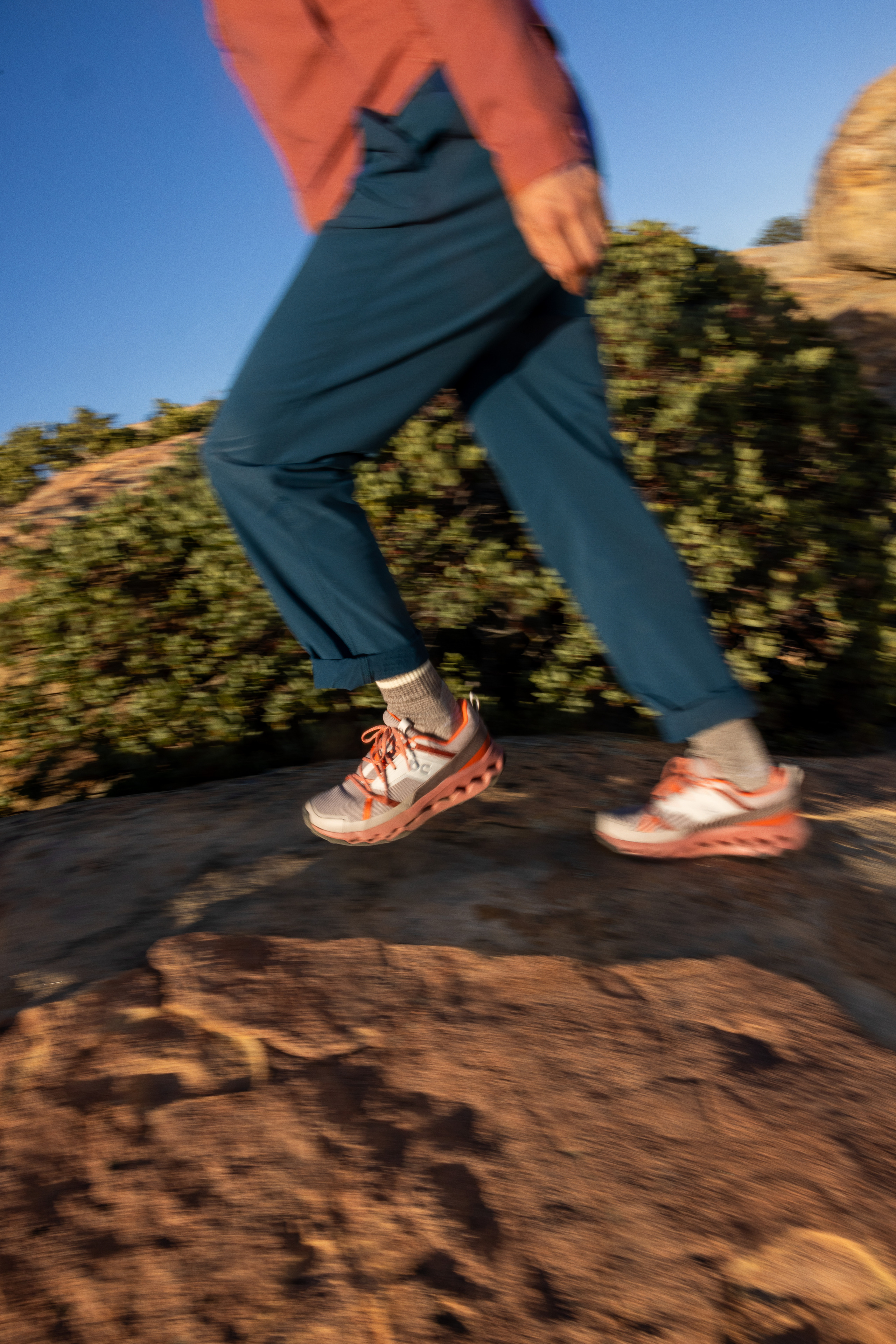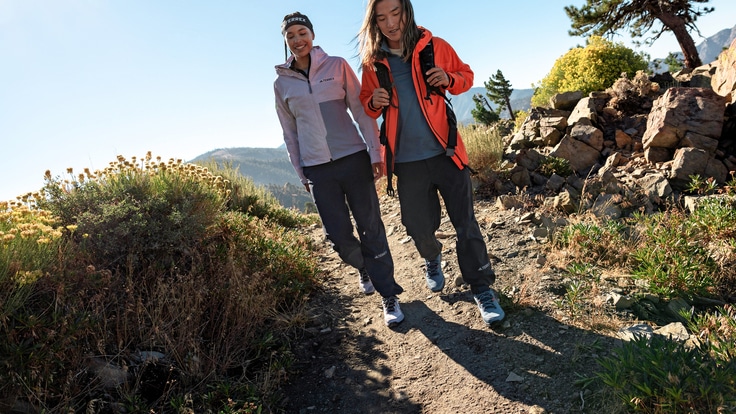Hiking shoes are a great alternative for someone looking to get out on the trail without heavier, stiffer hiking boots. Why? Hiking shoes tend to be just the opposite—lighter weight and more flexible—while still delivering top-notch traction, stability and durability. Essentially, they marry the best attributes of a hiking boot with those of a trail-running shoe.
For many outdoor lovers, hiking shoes deliver the Cinderella fit for two important—and interconnected—rules of the trail, notes Carlos Rodriguez, a long-distance mountain runner and department manager at the REI store in Wichita, Kansas. First, have fun. If you're not enjoying your time, then you're wasting it, he says. Second: Pick the right shoe. "If we can keep rule two intact, then rule one is pretty safe."
So how can you determine the right option for your foot? "The mark of a good shoe," Rodriguez says, "is that I'm not thinking about it when I'm outside."
Here, we've compiled our list of truly forgettable hiking shoes (and we mean that in the best way possible). The picks below are based on REI staff experiences and supported by positive customer reviews. Consider the favorites in eight different categories (bearing in mind what makes your specific foot-type happy), head to an outdoor specialty store like your local REI to check out the goods and get out there.
Read: Hiking Boots vs. Hiking Shoes: What's the Difference?
Staff Picks
Find quick recommendations below or scroll down for in-depth reviews.
Best Overall Hiking Shoes: HOKA Speedgoat 6 Trail-Running Shoes
Most Comfortable Hiking Shoes: adidas Terrex Free Hiker GORE-TEX 2.0 Low Hiking Shoes
Best Hiking Shoes for Technical Terrain: Salomon X Ultra 4 GORE-TEX Hiking Shoes
Best Hiking Shoes for Thru-Hiking: Altra Lone Peak 8
Best Hiking Shoes for Beginners: Merrell Moab 3 Hiking Shoes
Best Fast-Moving Hiking Shoes: On Cloudhorizon Hiking Shoes
Best Budget Hiking Shoes: Merrell Speed Solo Hiking Shoes
Best Minimalist Hiking Shoes: Xero Shoes Scrambler Low Hiking Shoes
Best Overall Hiking Shoe
HOKA Speedgoat 6 Trail-Running Shoes
Waterproof No
Upper Woven textile
Midsole CMEVA
Outsole Vibram® Megagrip with Traction Lug
Heel-to-toe drop 5 mm
Weight (pair) 1 lb. 04 oz. (women's); 1 lb. 3.6 oz. (men's)
The Speedgoat 6 by HOKA is a trail runner designed with help from legendary ultrarunner Karl “Speedgoat” Meltzer, who’s won more 100-mile races than any runner. Naturally, it’s intended for extralong pushes on terrain where traction matters. While it was made for higher-speed off-roading, these shoes are also beloved by long-haul hikers. That’s why one hostel popular with Appalachian Trail hikers has a framed photo of trail-worn Speedgoat 4s. “Certainly there is a huge following among hikers for what was engineered as a trail runner,” Rodriguez says, “even though we hopefully will never be running from a bear.”
With its most recent update, the Speedgoat 6 is a half-ounce lighter per shoe (thanks to a lighter CMEVA midsole compound) while retaining its roughly 40-mm stack height, known for its blend of comfort and agility over different types of terrain, no matter the distance traveled. “Traditional hiking boots and hiking shoes can be heavy,” says thru-hiker Elizabeth Nguyen, who works as a senior retail specialist in the camping department at the Atlanta REI store. “These aren’t. It feels like you’re wearing an everyday sneaker.” Meanwhile, the late-stage Meta-Rocker profile in the forefoot boosts stability and offers smooth-as-butter launches by letting the forefoot rest on the ground just a touch longer between strides.
For ultimate grip, the Speedgoat 6 boasts 5 mm lugs and Vibram® Megagrip, a no-nonsense outsole that holds tight to the trail and doesn’t let go. “They absolutely cling to the ground as I run through the slippery leaves of Smoky Mountain trails,” says Elizabeth Pratt, store sales specialist at the REI store in Knoxville, Tennessee. Pratt is a big fan of the snug grip around the heel (courtesy of the molded EVA sockliners), which prevents blister-causing friction. Protective rubber toe rands prevent wear in vulnerable spots.
The Speedgoat 6 features recycled, double-layer jacquard mesh uppers in can’t-miss-‘em colors—and the whole construction happens to be vegan-friendly. The combination of tactical grip, trustworthy stability and plush, lightweight comfort—all at a mid-range price point—earned the Speedgoat 6 a spot at the top of our list. (Also available with a waterproof GORE-TEX membrane in women's and men's, and in a mid version in women's and men's.) Buy women's. Buy men's.
Most Comfortable Hiking Shoes
adidas Terrex Free Hiker GORE-TEX 2.0 Hiking Shoes
Waterproof Yes
Upper Synthetic/textile
Midsole Boost foam
Outsole Continental rubber
Heel-to-toe drop 10 mm
Weight (pair) 1 lb. 10.7 oz. (women's); 2 lbs. 0.6 oz. (men's)
Its widespread familiarity makes adidas a great entry point for someone looking for a new pair of hiking shoes, says senior retail specialist Elizabeth Nguyen from the REI store in Atlanta, and it certainly helps that the Terrex Free Hiker is a comfort-first shoe with serious outdoor-activity cred. Adidas has taken on the trails over the last few years, and the Terrex Free Hiker demonstrates the brand's goal to help people move fast in the mountains.
Proprietary Boost™ technology in the midsoles contributes the hiking shoe's comfy-from-the-first-step sensation. Introduced in 2013, Boost is made from thermoplastic polyurethane particles expanded to create closed cells encasing small air pockets, adding delicious cushion while delivering standout energy return and durability. The resulting "bounce" effect proves to be a knee-saver on descents, according to one reviewer, who also appreciates the inclusion of soft materials in the upper where the shoe brushes against their skin. "Most comfortable trail running shoes," they say. "These will replace my backpacking shoes!"
The midsole also features an EVA frame and external heel clips to increase lateral stability on uneven and unstable terrain. Underfoot, Continental rubber (from a leading car and bike tire manufacturer) delivers dependable traction, while a waterproof but breathable GORE-TEX Performance Comfort membrane and abrasion-resistant mesh grace the shoe's upper. (Vegans will be glad to hear the Terrex Free Hiker is made without animal-derived products.)
Those powers combine to form a "well-protected trail shoe," says another customer-reviewer from Washington, who took them for a 40-mile spin with a 35-pound pack. "The beefy Continental outsole was grippy on wet rocks and slick dirt and provides a secure feeling platform for the entire shoe. … It's built to get knocked around and provides great protection from rough trails."
Note that the Terrex Free Hikers tend to run about a half-size big, so consider sizing down. Buy women's. Buy men's.
Best Hiking Shoes for Technical Terrain
Salomon X Ultra 4 GORE-TEX Low Hiking Shoes
Waterproof Yes
Upper Synthetic
Midsole EnergyCell
Outsole All Terrain Contagrip® rubber
Heel-to-toe drop 11 mm
Weight (pair) 1 lb. 6.1 oz. (women's); 1 lb. 11.5 oz. (men's)
Have a craggy, chossy, slick or otherwise technical trail in your sights? Reach for a workhorse like the X Ultra 4 GORE-TEX Hiking Shoes from Salomon. "I'm a big fan of the Salomon hikers," says Komilla Bhatty, who works at REI as a senior manager of environmental health and safety. She calls them her go-to shoes for hiking. "I love the fit, the comfort and the grip. They're flexible and provide a lot of support, even on longer hikes," she says.
The X Ultra 4s feature a waterproof GORE-TEX exterior so splashes won't penetrate to your skin, and an updated midsole equipped with an ADV-C chassis. The result: optimized stability on gnarly paths while remaining flexible at the shoe's front. Salomon SensiFit™ technology further boosts your foot's feeling of security because it works with the single-pull QuickLace system to effectively cradle the foot securely in the shoe. It's kind of like a full-foot hug. Active Support "wings," or side material that envelopes the foot when the QuickLaces are engaged, further enhance the effect. Contagrip® MA outsoles marry multidirectional lugs with a stick-to-anything proprietary rubber. "I absolutely love them," says Don Ely, REI principal software engineer. "Little to no break-in period, sturdy, comfortable and keep my feet dry in the moist Pacific Northwest."
The women's X Ultra 4 uses softer materials around the shoe collar and heel and includes a lower-density (therefore lighter weight and slightly less stiff) chassis. (Also available without a waterproof GORE-TEX membrane in women's and men's.) Buy women's. Buy men's.
Best for Hiking Shoes for Thru-Hiking
Altra Lone Peak 8 Trail-Running Shoes
Waterproof No
Upper Ripstop mesh
Midsole Altra EGO foam
Outsole MaxTrac rubber
Heel-to-toe drop 0 mm
Weight (pair) 1 lb. 2.3 oz. (women's); 1 lb. 5.4 oz. (men's)
Carlos Rodriguez doesn't mince words when describing the Lone Peak line from Altra. The long-distance mountain runner and department manager for REI in Wichita, Kansas, notes the shoes were originally designed for the ultra-trail-running community. "They're a juggernaut," he says. "These shoes can take a hell of a beating." That's because their refined, ripstop upper defies tears and scratches, while sturdy TPU StoneGuards™ protect against any boulders, scree or pointy pebbles the trail serves up underfoot. The Lone Peak 8 strikes a balance between cushion and responsiveness through its EVA-derived, compression-molded Altra EGO™ midsole foam and finds equilibrium between traction and durability with rubber-based MaxTrac™ outsoles.
What really differentiates any Altra shoe is the brand's zero-drop construction. While traditional running shoes have a 10- to-12 millimeter height difference between the heel and toe, zero-drop shoes remain level throughout. This framework encourages landing on your midfoot or forefoot more than your heel, which can help prevent stress on knees and help with kicker turnover, among other things. If you're new to zero-drop shoes, be ready for an adjustment period, but don't be intimidated. (For more information about zero-drop shoes and how to begin wearing them, read Minimalist/Barefoot Running Basics. Note that the other zero-drop shoe on this list is the Xero Shoes Scrambler Low Hiking Shoes.)
One self-described "flat-footed" reviewer from Delaware, who uses the Lone Peak 8 for hiking, running and walking, says, "I tried these on recommendation of the staff at the Las Vegas REI. They were very comfortable, and the roomy toe box was great, [but] I almost put them back as the design is such a departure from typical shoes. I am glad I didn't. These are excellent."
Speaking of that toe box, the Lone Peak 8 features the Altra Original Footshape™ fit, what the brand calls the roomiest of its fit options. That noticeably broad-in-the-forefoot silhouette allows toes to splay wide for better stability, for a footfall that mimics barefoot running while still delivering cushion and protection. Another reviewer from Texas agrees: "The wide fit is a foot-saver for me," he says. "Good trail hiking shoe, and still in good condition [after two years]." Buy women's. Buy men's.
Best Hiking Shoes for Beginners
Merrell Moab 3 Hiking Shoes
Waterproof No
Upper Pigskin leather/mesh upper
Midsole Super Rebound compound
Outsole Vibram TC5+
Heel-to-toe drop 11.5 mm
Weight (pair) 1 lb. 10 oz. (women's); 2 lbs. 1 oz. (men's)
Thru-hiker Elizabeth Nguyen, who works as a senior retail specialist at the REI store in Atlanta, trusts the traction, comfort and durability of the Moab 3 Hiking Shoes from Merrell. That's why she wore them on her 2016 push on the Appalachian Trail. It's also why the Moab is often the first shoe she recommends, yes for those going long distances but also for beginners or when helping hiking boot users transition into a hiking shoe. "It's the shoe that does everything," she says. "It's great for hiking. No breaking-in is needed at all. You wear it and it's comfortable. That's it. You're good to go."
Many aspects of the Moab 3 are drawn from the brand's 40-plus-year boot-making history. The shoe's no-slip grip comes from its versatile, Merrell-exclusive Vibram® TC5+ non-marking outsoles, which are designed for reliable traction on a wide range of surfaces, including everyday indoor wear. Molded nylon arch shanks keep feet steady on rough trails. Comfort takes shape in the Kinetic Fit™ Advanced removable, contoured insoles with reinforced cushioning in the heel delivering moderate support; shock-absorbing Super Rebound Compound in the midsole; and stabilizing Merrell Air Cushion in the heels. The shoe's top-shelf materials —including dual gold-rated leather/mesh uppers—contribute to its impressive durability. All that, and this updated Moab features recycled materials in the mesh lining, laces and webbing.
"I own and love the Merrell Moab 3," says Kristi Wisen, a program manager with the REI finance team. "They are my go-to hiking boots. I have tried so many others and always go back to Merrell." (Also available with a waterproof membrane in women's and men's.) Buy women's. Buy men's.

Best Fast-Moving Hiking Shoes
On Cloudhorizon Hiking Shoes
Waterproof No
Upper Polyester/TPU
Midsole Helion™ superfoam
Outsole Missiongrip rubber
Heel-to-toe drop 6 mm
Weight (pair) 16.7 oz. (women's); 1 lb. 1.2 oz. (men's)
Not every hike has to be about snagging a PR, but for the outings that are, look to the Cloudhorizon Waterproof Hiking Shoes from speed specialist brand On. Breathable and lighter than many other hiking shoes, the all-new Cloudhorizon still promises durability and traction. When going fast is the goal, you'll appreciate how the brand's signature CloudTec Phase® midsole technology, which uses Helion™ superfoam to provide just-enough cushion while facilitating a smooth toe-off, helps you roll smoothly through your stride. Missiongrip™ rubber outsoles might have lower lugs than competitors, but they provide ample hold on mild and moderate trails, even when the path ahead is wet.
"These Cloudhorizon hiking shoes feel stable and give the right amount of cushion, without being mushy. … I've read they can be narrow, but the Cloudhorizon is plenty roomy for my wide-ish feet. The true test will be distance walking in the UK in May, where I expect to be walking off-road 7-12 mi/day for a week," says one customer-reviewer from Spokane, Washington.
The fast-tracker isn't just about fast, however. Sustainability features also come into play with an impressive 32% recycled content overall including 85% recycled polyester. Buy women's. Buy men's.
Best Budget Hiking Shoes
Merrell Speed Solo Hiking Shoes
Waterproof Yes
Upper Waterproof suede/recycled non-wicking mesh
Midsole FloatPro Foam
Outsole Vibram ECOSTEP rubber
Heel-to-toe drop 10 mm
Weight (pair) 1 lb. 4 oz. (women's); 1 lb. 8 oz. (men's)
Many feel that function over fashion is the only way to go when gearing up for time on the trail. But the Speed Solo hiking shoes from Merrell provide both in equal measure—and approachably priced. "Let's be honest: A lot of hiking shoes, they're very boring," says Elizabeth Nguyen, an experienced thru-hiker and senior retail specialist at the Atlanta REI store. Talking up the shoe's trail-to-town versatility, she adds, "You go hiking, and then you go have coffee with your friends."
Nguyen appreciates how the Speed Solo pairs multiple performance-focused elements—lightweight FloatPro Foam™ midsoles, Vibram® ECOSTEP (designed with 30% recycled rubber) outsoles, a protective rock plate, 4-millimeter lugs and waterproof suede—with multiple color options (go bold ... or don't) and an on-trend retro look.
The Speed Solo includes a variety of sustainability features, like fully recycled laces, webbing and mesh linings, and BLOOM™ performance foam made with renewable algae. You'd be hard-pressed to find a better hiker at or under this price point, especially from a brand that knows the trail like Merrell, which has been making shoes since 1981. Buy women's. Buy men's.
Best Minimalist Hiking Shoes
Xero Shoes Scrambler Low Hiking Shoes
Waterproof No
Upper Polyester textile/TPU
Midsole Polyester textile
Outsole Michelin rubber
Heel-to-toe drop 0 mm
Weight (pair) 14.8 ounces (women's); 1 lb. 2.4 oz. (men's)
Minimalist shoes are designed to offer as close to a barefoot running experience as possible while wearing something protective on your feet, which is often argued as helping improve cadence and speed, encourage a more natural running stance and lessen recovery time. They're highly flexible, generally lightweight and have a flatter profile with less of a drop from heel to toe. The Scrambler Low hiking shoes from Xero Shoes is a no-brainer choice as the top minimalist hiking shoe on this list. "That shoe is as close as you can go to barefoot and still have close-toed shoes," REI Atlanta senior retail specialist and experienced thru-hiker Elizabeth Nguyen says.
The shoe's barely-there feel comes from a combo of lightweight materials (like Michelin fiberlite technology in the outsole), a wide toe box that allows the forefoot to splay naturally and a low-to-the-ground profile with zero-drop construction. Mountain bike tires inspired the nubby soles, which provide far better traction than actually going barefoot.
"The shoe is phenomenal," says Carlos Rodriguez, a long-distance mountain runner and department manager at the REI store in Wichita, Kansas. "It's extremely light. It's extremely pliable. The lugs are aggressive, so you can run in these guys. They're the real deal when it comes to minimalist hiking shoes." Says one customer-reviewer in Los Angeles, "This is an amazing minimalist hiking shoe and exactly what I was looking for. … The tread grips dirt better than any other shoes I've worn and the rubber compound inspires full confidence on smooth rock. Were a pleasure to wear while exploring Zion."
As with the zero-drop Altra Lone Peak 8 Hiking Shoes, you may need to transition gradually to these if you're new to minimalist or barefoot-style shoes. For more information about zero-drop shoes and how to begin wearing them, read Minimalist/Barefoot Running Basics. Buy women's. Buy men's.
Buying Advice
REI experts say there really isn't an objectively best or worst hiking shoe. "There's a lot of 'different,'" notes Carlos Rodriguez, long-distance trail runner and department manager at the REI store in Wichita, Kansas. "It's going to come down to what your wants and needs are."
When you're trying to find the hiking shoe that works for you, you'll want to consider several factors, including the proper size, shoe traction, flexibility, weight and whether you need waterproofing.
Sizing
Our feet swell throughout the day, even when we're doing run-of-the-mill activities. Remember that when deciding what size hiking shoe to purchase. The best bet for getting the right size: Go into your local REI for an in-person fitting, ideally at the end of the day when your feet are at their largest. When you do, be sure to wear hiking socks similar to what you might wear on your next outing. (Read How to Choose Hiking Socks and check out our Best Hiking Socks of 2024: Staff Picks.)
Traction
The efficacy of a hiking shoe's traction—its ability to grip the ground—comes from the lugs' depth and the outsole material.
Lugs are the protrusions on the bottom of your hiking shoe, and they help keep us upright by digging into the dirt or clutching onto the rock. They also serve as a defensive layer between our feet and the ground. Some brands go a step further by designing each lug's shape and pattern to best suit the shoe's intended movement or environment. (Note that deeper lugs means more rubber, which means more weight.) The HOKA Speedgoat 6, Altra Lone Peak 8 and Merrell Moab 3 have 5-millimeter lugs. The adidas Terrex Free Hiker GORE-TEX 2.0 Low and Merrell Speed Solo have 4-millimeter lugs. The Salomon X Ultra 4 lugs are designed in a chevron pattern, designed for speedy ascents; slower, safer descents; and multidirectional traction on looser terrain like gravel or dirt.
Hiking shoe outsoles are made from a wide range of different rubbers with varying levels of "stickiness." Softer rubber compounds usually have better grip, but they can be less durable and wear out faster than harder rubber compounds.
Since hiking shoes are designed for the trail, they're all going to have relatively good traction, thru-hiker and REI Atlanta senior retail specialist Elizabeth Nguyen says. "If it fits you well in the toe box and heel areas, then the traction will do the job it's meant to do."
Flexibility
A hiking shoe's stiffness or flexibility depends on its midsole construction. Hiking shoes with more flexible midsoles will likely be more comfortable, even right out of the box. Since they're made with softer, less-dense materials and typically have fewer supportive layers, they're also lighter and may feel less clunky. On the other hand, they may also be less durable than a stiffer shoe.
More traditional hiking shoes have a stiffer midsole, designed to sustain additional compression on our feet from wearing a heavier backpack. A stiffer midsole can also reduce foot strain by preventing the arch from curving around rocks or roots and helps protect the soles of our feet. Stiffer hiking shoes are likely to last longer but weigh more.
Weight
How much weight matters when choosing hiking shoes depends on your goals.
If your priority is speed and comfort, then opt for a lighter shoe. Just keep in mind that the lighter shoe (especially if it has a less robust build) will likely be less durable and less supportive.
If you want more support and durability, heavier hiking shoes tend to be made with tougher materials (e.g., leather uppers, denser and/or luggier outsoles) and include more supportive elements like a shank or rock plate. While a burlier shoe might not wear out as fast as a lighter one, you might wear out faster if you're not used to wearing something heavy on your foot.
The lightest hiking shoes in this guide are the women's Xero Shoes Scrambler Lows at 14.8 ounces. The men's Merrell Moab 3 shoes are the heaviest, just over 2 pounds.
Ultimately, our experts say it's a continuum between lightweight, speed and comfort versus protection, durability and stability. Which hiking shoe is best for you comes down to personal preference, foot type and your objectives.
Waterproofing
Many hiking shoes—including several on this list—come in both nonwaterproof and waterproof versions. The HOKA Speedgoat 6, adidas Terrex Free Hiker 2.0, Salomon X Ultra 4, Altra Lone Peak 8, and Merrell Moab 3 are available as both. The On Cloudhorizon is only available in a non-waterproof version.
Even standard hiking shoes typically offer some water protection on the outsole and likely through the midsole. Truly waterproof shoes also have that water protection in the shoe's upper, either through a durable water repellent (DWR) coating or built-in liner. GORE-TEX, eVent® and Outdry are some of the most well-known waterproof technologies.
Experts agree you may want waterproof hiking shoes if:
- You plan to encounter some moisture, such as dewy grass, puddles or melting snow.
- You're in cool or cold conditions, as waterproof barrier obstructs airflow, trapping more of the heat your foot generates.
You may not want waterproof hiking shoes if:
- Your body tends to run hot, as waterproof shoes are less breathable.
- You'll be in a more humid environment, as that lower breathability can cause your feet to overheat and sweat more, which can cause blisters.
- You plan on tackling full water crossings or submerging your shoes, since waterproof barriers will keep water in just as well as they keep it out and may stay wet for a long time. Instead, opt for a quick-drying hiking shoe or consider a hiking sandal instead.
Related reading: Should I Get Waterproof Trail-Running Shoes?
Methodology
We polled REI staff and Members and reviewed customer feedback to determine these avid users' top hiking shoes based on comfort, stability and support. These are their favorites available at REI.












































































